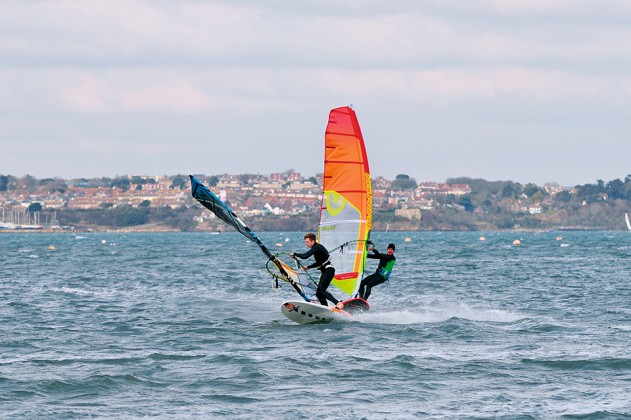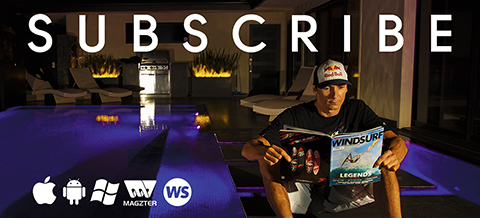THE SIZE OF COMPROMISE.
7.0M FREERACE SAIL TEST 2016.
Test Editor Tris Best // Second Testers Maurin Rottenwalbter, Dan Hallam, Tom Wells & Scott Stallman
Photos Andy Stallman // Test Location OTC, Portland, Dorset
The very definition of freerace, as we explored in the board test elsewhere in this issue, is to do with bridging the gap between slalom and freeride. In other words, making a product both fast and user-friendly. For sail design that equates very simply to being able to produce an engine with the slippery efficiency to convert the wind’s energy to raw speed, and the top end stability to withstand the forces applied. But is that it? Is that all that is required – speed and stability?
This test was originally published in the April 2016 issue.
FINDINGS
Speak to some brands and they would argue that the magic formula is a little more complicated than that. Lets take a step back for a moment to consider the sail size of this category. For most recreational sailors, the very notion of owning a garage full of boards and sails for every possible eventuality is a thing of the past. Most if not all windsurfers nowadays are trying to own as few items as possible to cover the widest possible range of conditions. So the development that has taken place in rig technology in recent years is music to most recreational windsurfer’s ears. That is that smaller sails are now setting with deeper profiles to generate a fantastic amount of bottom end power, making them able to exact a much improved early planing performance, size for size. That means that an average weight rider (75-80kg) can now get away with a 7.0-7.5m as the largest sail in their quiver, whereas they’d have to opt for an 8.5m in the past to get planing in the same wind strength. Efficient low-end performance could only be a good thing, with the additional by-product that a 7.0-7.5m would also be more manageable in transition. All good so far, wouldn’t you agree? Unfortunately, the fact is that the theory flies in the face of the very concept of freerace. Isn’t bottom end power compromised when trying to optimise top end stability and speed …and vice versa? The answer has got to be yes, to an extent; maximising a wind range is always going to be a compromise. If you push the performance in light winds, you aren’t going to be able to keep up with the cream of the crop in ultimate top end performance. Yet when some brands are making their entire product range cleaner and more concise, pushing the wind ranges of their remaining lines, other brands are withstanding the urge to follow suit and retaining more specialist products in their larger line-ups. It leaves the choice largely in your hands as the consumer and the best thing is that you can influence the pathway of the market by your buying power. So when considering which of these sails is the power plant for you, ask yourself a few quick and easy questions – which board are you most likely to partner it with, and secondly, what conditions are you aiming to use it in? Are you intending to push your scope of light wind enjoyment, or are you looking to plug the sail into an efficient freerace hull and drag-race your mates in a blow? Many of the sails here are capable of doing both, yet others have a distinct bias towards one specific end of the wind range spectrum. Read the individual reports and decide the best match for you.
SUMMARY
Within this test group of nine sails is a diverse range of performances to suit every preference. In at the deep end, the Point-7 ACX is a high performance, top-end drag-racing machine, coming into focus when the wind is properly blowing. At the other end is the Goya Mark –a real powerhouse that lets you get away with a smaller sail than you might anticipate. The Severne and Neil Pryde both major on a slippery top end feel combined with incredible balance and light, crisp handling. We then have the North and RRD, both of which are focussed on extending their wind range as best as possible. The Vandal is designed to do the same, yet the result is undoubtedly more freeride (light to comfortably powered winds) in nature than freerace (high winds). And so to the GA Sails and Simmer. Both steal the show to some extent, as their ability to set on a 430cm mast would have been unheard of for a 7.0m sail just a few years ago. By doing so it makes this sail size more accessible than ever, as an experienced rider extending their light wind quiver is now likely to be able to use their existing mast and boom, dramatically reducing the expense outlay required. And that increased accessibility can only be a good thing.
TEST LOCATION
This test was conducted at the Official Test Centre (OTC), on Portland, Dorset. The centre is based within the grounds of the National Sailing Academy that hosted the Olympic sailing classes in 2012. With the best wind stats on the south coast, mirror flat water in prevailing winds and a safe launch area with excellent facilities, it provides the ideal test venue. Much of the kit is still on site, so why not go and try some of it for yourself?
uk.otc-windsurf.com
THE LINE UP



